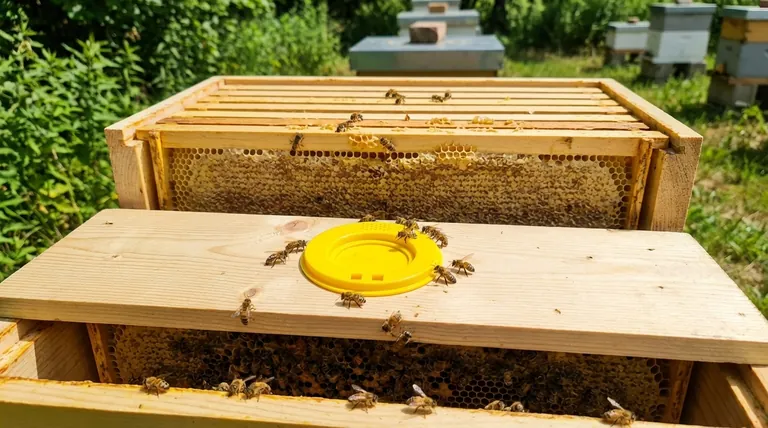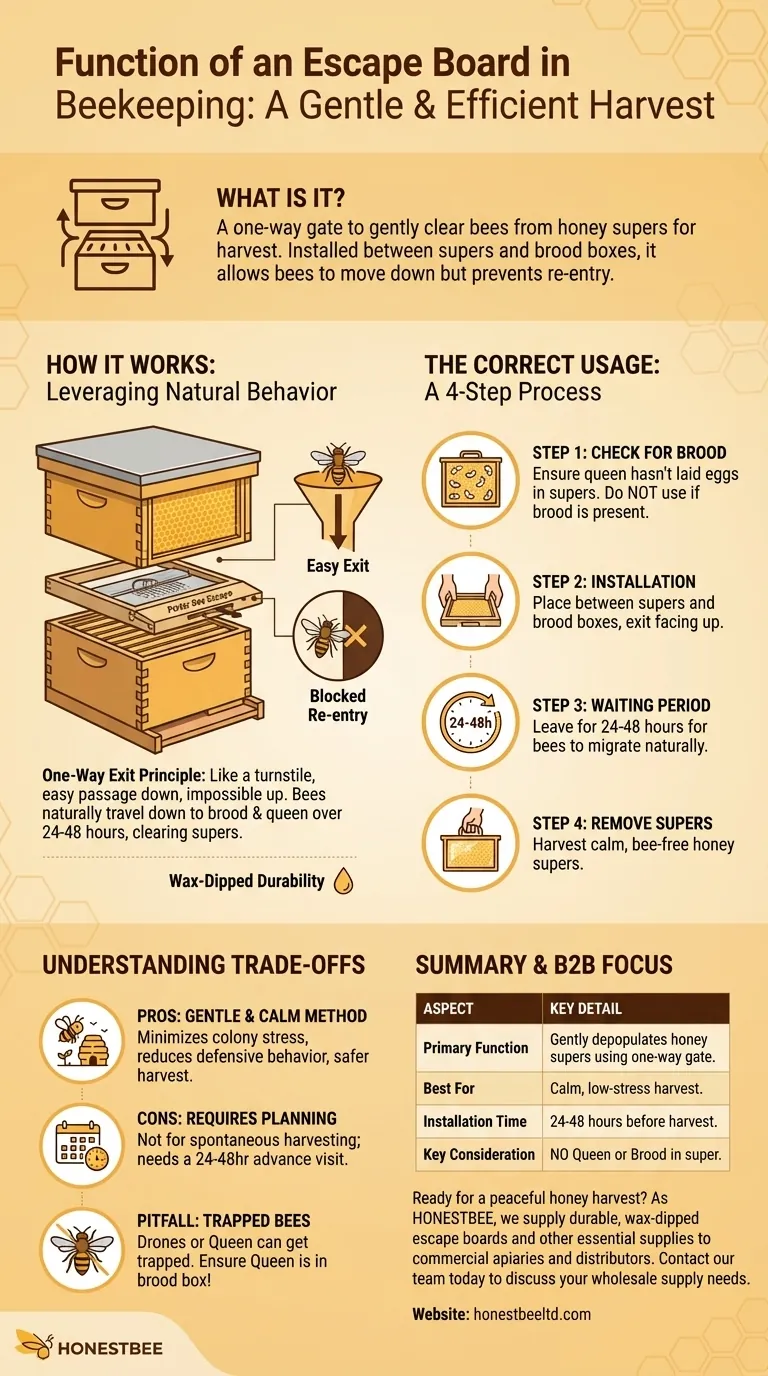In beekeeping, an escape board functions as a one-way gate to gently clear bees from honey supers before harvesting. This flat board, fitted with a special exit mechanism, is placed between the honey supers and the brood boxes below. It allows bees to move down into the main hive but prevents them from re-entering the supers, making honey collection significantly easier and less disruptive.
The core purpose of an escape board is to depopulate honey supers in a calm, passive manner. This method minimizes stress on the colony and the beekeeper, resulting in a more peaceful harvest and cleaner honey frames.

How an Escape Board Works
An escape board's effectiveness comes from its simple design that leverages natural bee behavior. Understanding this mechanism is key to using it properly.
The Principle of the One-Way Exit
At the heart of the board is a small maze or valve, often shaped like a triangle or the popular "Porter Bee Escape." This design creates a pathway that is easy for bees to navigate in one direction (out of the super) but confusing and nearly impossible to navigate in the reverse direction.
Think of it as a turnstile that only spins one way. Bees can easily push through or walk down the funnel, but when they try to return, they encounter a solid wall or a blocked, narrow entrance they cannot find.
Leveraging Natural Bee Behavior
The board works with the bees' instinct to maintain contact with the main cluster and the queen, which reside in the brood boxes below. Over the course of a day and night, bees in the supers will naturally travel down to the brood chamber.
Once they pass through the escape board's one-way exit, they are unable to return to the honey supers, effectively clearing them over time.
Construction and Durability
As the references note, escape boards are often wax-dipped. This treatment protects the wood from moisture and hive debris, ensuring the tool remains durable and functional for many seasons of use.
The Correct Way to Use an Escape Board
Successful use requires proper timing and placement. It is not an instant solution but a planned step in the harvesting process.
Step 1: Check for Brood
Before installing the board, inspect your honey supers. If the queen has laid eggs in them, an escape board should not be used. Nurse bees will not abandon the brood, rendering the board ineffective and potentially harming the developing bees.
Step 2: Installation
The escape board is "sandwiched" between the honey supers you plan to harvest and the brood boxes below. Ensure the exit mechanism is facing up, toward the honey supers, so the bees can travel down and out.
Step 3: The Waiting Period
Patience is crucial. The board should be left on the hive for 24 to 48 hours. This gives the vast majority of bees enough time to naturally migrate down into the brood chamber. Removing it too early will result in partially cleared supers.
Step 4: Removing the Supers
After the waiting period, you can return to the hive. When you lift the honey supers, you will find them nearly empty of bees, heavy with honey, and ready for extraction with minimal disruption to the colony.
Understanding the Trade-offs
Like any tool, the escape board has distinct advantages and disadvantages compared to other methods like using a bee brush or a fume board.
Pro: A Gentle and Calm Method
This is the primary benefit. By avoiding the need to forcibly brush or blow bees off frames, the colony remains calm. This reduces defensive behavior, minimizes bee casualties, and makes the entire experience less stressful for the beekeeper.
Con: It Requires Planning
The escape board is not a tool for spontaneous harvesting. It requires a dedicated trip to the apiary to install it one or two days before you plan to collect the honey. This makes it less suitable for beekeepers who need to get the job done in a single visit.
Pitfall: Trapping Drones or a Queen
Because drones are larger than worker bees, they can sometimes get stuck in the exits. More critically, if the queen is accidentally in a honey super when the board is installed, she will be trapped. Always ensure the queen is in the brood box before installation.
Making the Right Choice for Your Goal
The best method for clearing bees depends entirely on your management style, timeline, and goals.
- If your primary focus is a calm harvest with minimal disruption: The escape board is the ideal tool, provided you can plan 24-48 hours ahead.
- If your primary focus is speed and immediate harvesting: A bee brush or fume board is more suitable for a single-visit harvest, but you must be prepared for more agitated bees.
- If you are a new beekeeper: The escape board is an excellent choice, as it dramatically reduces the stress and chaos of your first few harvests.
Ultimately, using an escape board demonstrates a thoughtful approach to beekeeping that prioritizes the well-being of the colony.
Summary Table:
| Aspect | Key Detail |
|---|---|
| Primary Function | Gently depopulates honey supers using a one-way gate. |
| Best For | Beekeepers prioritizing a calm, low-stress harvest. |
| Installation Time | Place between honey supers and brood boxes 24-48 hours before harvest. |
| Key Consideration | Ensure the queen is not in the super and that no brood is present. |
Ready for a peaceful honey harvest? As HONESTBEE, we supply durable, wax-dipped escape boards and other essential beekeeping supplies to commercial apiaries and distributors. Our wholesale-focused operations ensure you get the reliable equipment you need to manage your hives effectively and humanely.
Contact our team today to discuss your supply needs and streamline your beekeeping operations.
Visual Guide

Related Products
- Circular Labyrinth Bee Escape for Efficient Hive Management
- High-Efficiency Diamond Maze Bee Escape for Clearing Supers
- Professional Durable Two-Piece Plastic Bee Escape
- Efficient Hive Clearing: HONESTBEE 8-Way Plastic Bee Escape
- HONESTBEE Multi Exit Plastic Bee Escape Board for Efficient Honey Harvesting
People Also Ask
- How does a bee escape board work? A Gentle Guide to a Stress-Free Honey Harvest
- What is a bee escape and why is it used in beekeeping? A Guide to Gentle Honey Harvesting
- How does an escape board work? A Gentle, Bee-Friendly Method for Harvesting Honey
- How long should a bee escape be placed before harvesting honey? The 24-48 Hour Guide to a Stress-Free Harvest
- What happens if Triangular Escape Boards are left on for more than 24 hours? Risk of Bee Re-Entry and Failed Harvest



















